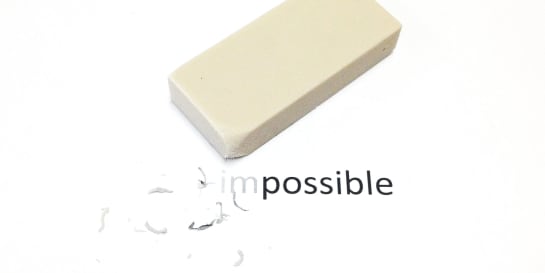Ever spent too much time on something that turned out to be based on the wrong assumptions? Here’s how to make sure that you’re investing your time correctly.
Assumptions Can Be Helpful … ¶
Think a moment about the assumptions on which you rely to get through a typical day in your life. Your routine on any given workday is probably based on the following basic assumptions, just to name a few:
- Your alarm will wake you up in time
- The transportation for your commute will function properly
- There will be the usual opportunities to get food and drinks throughout the day
Simply assuming these things—rather than verifying them one by one each day—successfully gets you through your workday routine most of the time. Sometimes, of course, things don’t work as assumed and your typical routine gets messed up. Generally though, relying on such basic assumptions has an extremely positive cost-value ratio: You can run on autopilot for the little things and have more brainpower left for the important stuff in your life.

… or Detrimental ¶
The more experience we have with a subject, the more assumptions we are ready to take in this matter. It’s our experience that helps us make the right assumptions most of the time. On the other hand, if we have no clue about something, we are more careful and hold back with assumptions.
Unfortunately, there is one area where we all continuously fall into the trap of believing that we’re experts—while we’re definitively not:
We all are experts in human beings, right? Everybody is one, after all!
This expertise in oneself leads to the “know one, know all” syndrome. Let me give you some examples that might appear familiar to you:
- A reckless car driver disrespects the traffic rules to your disadvantage. You swear at them since you assume they must be a disrespectful person, in general, to treat you this way.
- A parent doesn’t seem to care that their children throw a tantrum. You complain, assuming that the person must be a bad parent, in general, to indifferently let their kids behave like this.
What if I told you that the driver in the first example rushed to see their child after it was just hospitalized with severe injuries? What if the parent in the second example just had suffered the loss of their spouse? Under these circumstances, I’m quite certain, you’d immediately empathize with them and change your attitude towards them.
While a bit extreme, the above examples show effectively how one can completely misread situations. Now imagine how assumptions (and hence potentially misreading situations) can have a deep impact on your work. Let me highlight two cases that I experienced in my career:
Case 1: The Well-Thought-Out Project Mandate ¶
At one point, a large infrastructure project was launched. I was part of that team that subsequently received a written project mandate. It went into much detail about the project’s goal and specific requirements. It even included a specific deadline by when which new infrastructure services should go into operation.
The team was confused. “How could the project sponsor already define the new infrastructure services in such detail?”, we asked ourselves. “How could the project sponsor already define such a specific deadline?”, we wondered.
We didn’t properly challenge the project sponsor; he appeared very confident. We assumed that he had pondered long enough over the mandate and must have had good reasons for giving such specific instructions. As the given deadline put us under pressure right away, we didn’t lose any time and went immediately to work.
After four months of intense work and a lot of frustration, we finally admitted that the project wasn’t deliverable under the given terms. Only then, in the ensuing discussions with the project sponsor, we clarified the scope and requirements. This led to a complete reboot of the entire project.
Case 2: The Appropriate Project Governance ¶
On another occasion, we again received a mandate for another project. This time, however, it appeared to come from the wrong sponsor. According to the team’s assessment, the project would result in organizational changes that the project sponsor wouldn’t be able to enforce. He simply wasn’t on the appropriate management level and thus lacked the necessary managerial authority.
We identified this as the biggest risk for the project, so we challenged the project sponsor. As he insisted on his ownership of the project, we made sure to conduct a session with top management after a few weeks to collect early feedback on our concept. Sure enough, we brought up the project governance and were able to rectify it almost immediately—eliminating the project’s biggest risk at the earliest opportunity.
The only but immense difference between the two cases was the awareness of assumptions. Remember: Assumptions can be helpful. Fortunately, there is a way to benefit from the “autopilot efficiency” of banal assumptions while mitigating the inherent danger of the riskiest assumptions: an approach called RATs.

RATs: Riskiest Assumptions to Test ¶
Learning is great. Learning the hard way not so much.
You’ve learned the hard way if it’s tough or even impossible to recover from your mistakes. Just like in case 1 above: Your client didn’t know that they didn’t know what was needed. In most cases, such a revelation comes pretty late when correcting mistakes costs a lot.
The answer is a process with four steps:
- Identify and formulate the assumption that represents the highest risk of failure.
- Design the most reliable and fastest test that will produce a true/false result and upgrade your assumption to a fact.
- Run the test.
- Repeat.
These assumptions are called RATs. So if your client tells you “I know exactly what I need” you should smell a RAT, test this assumption and turn it into a hard fact. If your boss’ boss hands you a project order with detailed task lists and deadlines, making it look like a well-thought-out plan, you should smell a RAT and test it. A shitty first draft doesn’t become a sound concept only because someone up the hierarchy wrote it! If you develop a solution, don’t assume you know your user just because you have been using your solution. Define RATs instead and test them early and often with your real users.
In general: When it comes to other human beings, beware of your tendency to know anything. Devise a test, then test it.
Tips for Proper Testing ¶
When I say testing, I don’t necessarily mean asking. While it certainly is a very fast test, it rarely produces reliable results. So what are the rough guidelines for properly testing assumptions? To give you some concrete ideas on how to go about validating your RATs:
- Observe what your test subjects do in their environment; don’t ask what they assume they do.
- Use prototypes and test environments to put people in situations that are as close to reality as possible.
- If an observation is impossible, ask the persons who take the ultimate decision on the topic at hand. Eliminate hearsay and the dangerous assumed assumptions.
- Make your tests as real as possible by having the persons commit to something (like a follow-up action) or give up something valuable (like more of their time). Do they put their money/time where their mouth is?

I’d even recommend to combine and repeat tests. Getting consistent results from different tests (or from the same test repeated at different points in time) increases the reliability of your test results.
Conclusion ¶
RATs are a great way to spare ourselves the disappointment to invest a lot of resources into something that nobody needs. They help us to be more successful at what we do for a living.
I’ve started to systematically scan for RATs whenever someone asks me to dedicate a substantial amount of time or money to something. By testing these assumptions, people effectively show, don’t tell me what they mean.
Start smelling and testing RATs in your environment, too. This way, whatever’s doomed to fail can fail early—leaving you and others to spend more on what’s well spent!
So, under what risky assumptions are you operating right now?

Michael Schmidle
Founder of PrioMind. Start-up consultant, hobby music producer and blogger. Opinionated about technology, strategy, and leadership. In love with Mexico. This blog reflects my personal views.
Jan 14, 2020 · 5min read
Improving Your Chances With Non-Negotiables
Your chances of winning any game improve drastically once you learn the rules. But what if there aren’t any clear rules? Non-Negotiables are here to help. Continue…
Jun 4, 2022 · 6min read
The Power of Subtractive Thinking
What’s better: more success or less failure? More possibilities or less impossibilities? Let’s take a look at the seemingly pointless question—and discover the surprising answer. Continue…
Oct 4, 2021 · 4min read
Being Productively Creative—Artist vs. Designer
Have you ever experienced “writer’s block” or “masterpiece syndrome?” Here’s some advice on how to frame your mind, get into problem solving and be productively creative. Continue…
Jan 15, 2021 · 10min read
S2S: Stairs to Success
For most of us, success depends on the interaction with other human beings. S2S is a simple method that can help you be more successful. I’ll show you how. Continue…



